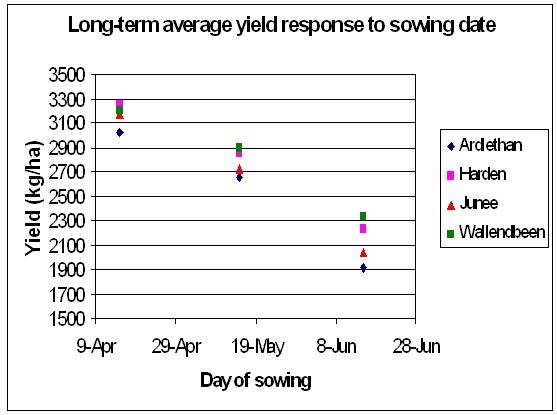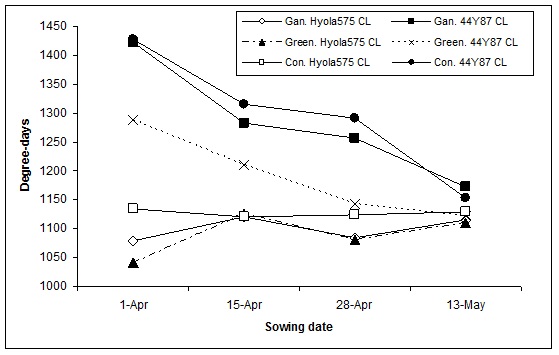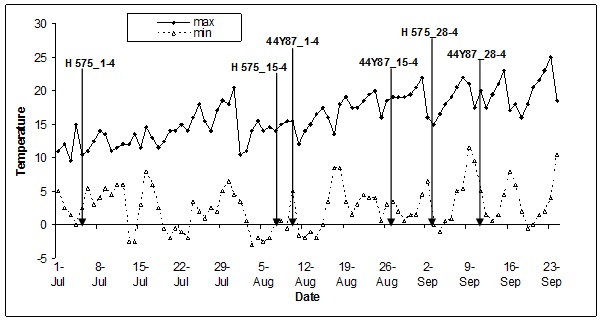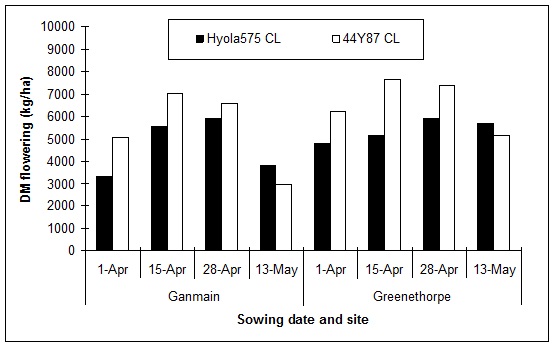Early sowing of canola in southern NSW
Author: Rohan Brill, John Kirkegaard, Julianne Lilley, Ian Menz, Don McCaffery and Colin McMaster | Date: 17 Feb 2015
Rohan Brill1, John Kirkegaard², Julianne Lilley², Ian Menz1, Don McCaffery1 and Colin McMaster1
1NSW DPI; ²CSIRO Canberra.
GRDC project code: CSP00187
Keywords: canola, development, phenology, early sowing.
Take home messages
- Simulations of early sown canola (early-mid April) predict higher grain yield potential in southern NSW.
- Early sowing (early April) of canola exaggerates inherent phenological differences between commercial canola varieties.
- In 2014, slower developing spring varieties had their highest yield from early sowing.
- In 2014, faster developing spring varieties were at flower/early pod-fill before and during the harsh frost period of early August if sown early, which reduced grain yield at frosty sites.
- Early sowing maximised yield of all varieties in the absence of frost and water stress.
- Initial results from 2014 experiments and modelling suggest that early sowing of canola may be feasible in low-medium rainfall regions with correct variety choice.
Introduction
Anzac Day (25 April) has been the traditional target date to commence planting canola in southern NSW. There is an abundance of research that shows that this late April/early May window is higher yielding than later sowings. Lisson et al. (2007) and Robertson and Kirkegaard (2005) both report negative correlations between sowing date and grain yield in southern NSW and that most of the variability in performance of canola between situations is due to differences in water supply and sowing dates. Recently, as a result of changing seasonal conditions there is interest in sowing canola earlier in April to increase yields. However, aside from research on grazed crops, there is little experimental data or commercial experience of canola sown in early April, especially in low-medium rainfall zones.
In spite of the lack of research data to justify the change in canola management, target sowing windows have shifted earlier than the traditional Anzac Day window in recent seasons. There appear two major reasons for this:
- To utilise seedbed moisture to establish crops from late summer and early autumn rain events.
- To increase grain yield potential by reducing exposure to dry and warm springs.
Early sowing of canola - simulation studies
Simulation studies conducted with APSIM based on historical climatic data indicate increased grain yield potential across several locations in southern NSW from sowing on 15 April compared to 15 May and 15 June (Figure 1).

Figure 1. Simulated yield response to sowing date at Ardlethan, Harden, Junee and Wallendbeen.
An issue with APSIM predictions for canola is that newer hybrid varieties are not well characterised within the model; however there has been enough data generated by APSIM to develop a hypothesis that early sowing of canola increases grain yield potential. The five year GRDC-funded project ‘Optimised Canola Profitability’, which commenced in 2014, will test this hypothesis in a coordinated approach across Northern and Southern Grains region. The project will also examine the critical management factors to consider for early sowing of canola, such as:
- Interactions with starting soil moisture.
- Cultivar selection (especially as related to the phenology and physiology of canola cultivars).
- Nitrogen rate and timing.
- Planting configuration (seeding rate and plant spacing).
Factors influencing canola development
The main controls of development in canola are:
- Basic temperature response.
- Vernalisation response.
- Photoperiod response.
Basic temperature response
The basic temperature response is the response of a variety to thermal time (degree-days) when both photoperiod and vernalisation requirements are met. Some differences exist in the basic temperature response amongst current commercial varieties in the time taken to floral initiation, but this is less important than the differences due to vernalisation or photoperiod response. However the basic temperature response is the main driver of development after floral initiation. The base temperature for canola development is 0°C and the optimum temperature is 20°C.
Vernalisation response
Vernalisation describes the need for periods of cold to initiate plant response. Varieties with a strong vernalisation response (‘winter’ types such as Hyola®971 CL) require a prolonged period of cold temperature to initiate floral development. In the case of some of the ‘spring’ canola varieties in Australia, this long period of cold temperature may not be required, but it can still shorten the interval (in thermal time) from sowing to floral initiation. It is expected that early sowing of canola into a relatively warm period (viz. sowing in early April v mid May) will lead to a delay in the accumulation of vernalisation (as there is usually no prolonged period of cold temperature in April). This will exaggerate the differences in flowering dates of varieties with different vernalisation requirements. In the experiments reported here, all varieties are nominally ‘spring’ varieties (i.e. vernalisation is not a necessity) with the exception of the one winter variety Hyola®971 CL (vernalisation is necessary).
Photoperiod response
Varietal response to photoperiod occurs between emergence and floral initiation. Canola is a long day plant, meaning that the duration from sowing to floral initiation is reduced in long day situations. In the commercial dataset evaluated by Robertson et al. (2014), varieties responded to day length in the range of 10.8 to 16.3 hours. A further separate study on different varieties showed greatest response between 12 and 14 hours (Nanda et al. 1996). For canola plants emerging in mid-April after an early April sowing, there is potential that some of the photoperiod requirement could be met in autumn where day length is longer than mid-winter, and hasten time to flowering.
Monitoring phenology of commercial cultivars - 2014
An understanding of varietal development as well as characterisation of a particular environment enables varietal choice and sowing date decisions to be made so that optimum flowering times can be targeted and both frost and heat risk are minimised during reproductive development. In addition the vegetative period needs to be long enough so that the crop sets enough yield potential to optimise water use.
To determine the varietal response to early sowing, a small set of varieties were sown in experiments at a range of locations in 2014 from the Eyre Peninsula in South Australia to Gatton in southern Queensland. This paper reports data from three sites in southern NSW with contrasting environments; Ganmain, Greenethorpe and Condobolin (Table 1).
Table 1. Environmental conditions at three canola trial sites in 2014.
|
Nov 13-Mar 14 Rainfall |
Apr 14-Oct 14 Rainfall |
Minimum temperature |
Available N (sowing) |
Applied N |
|
|---|---|---|---|---|---|
|
Ganmain |
100 mm |
270 mm |
-3.5°C 14 August |
60 kg/ha (0-120 cm) |
170 kg/ha |
|
Greenethorpe |
187 mm |
332 mm |
-1.4 11 August |
250 kg/ha (0-200cm) |
100 kg/ha |
|
Condobolin |
180 mm |
180 mm |
-5.3°C 3 August |
175 kg/ha (0-60 cm) |
10 kg/ha |
There were slight differences in the date of flowering of the varieties at the three sites; however the varietal trends were similar. From the 1 April sowing date Hyola®575 CL was the quickest variety to reach flowering (50% of plants with one open flower) at all sites. From this sowing date, Hyola®575 CL was 38, 27 and 27 days quicker than Pioneer®44Y87 CL at Ganmain, Greenethorpe and Condobolin, respectively. As sowing was delayed until 13 May, the difference in days to flowering of Hyola575 CL compared with Pioneer®44Y87 CL was reduced to six, one and two days at Ganmain, Greenethorpe and Condobolin, respectively.
Table 2. Date of flowering (50% of plants with one open flower) of canola varieties sown at four sowing dates at Ganmain, Greenethorpe and Condobolin in 2014.
| |
Ganmain |
Greenethorpe |
Condobolin |
|||||||||
|---|---|---|---|---|---|---|---|---|---|---|---|---|
|
1-Apr |
15-Apr |
28-Apr |
13-May |
1-Apr |
16-Apr |
28-Apr |
13-May |
1-Apr |
15-Apr |
28-Apr |
13-May |
|
|
Hyola®575 CL |
12-Jun |
20-Jul |
15-Aug |
6-Sep |
16-Jun |
25-Jul |
9-Aug |
30-Aug |
20-Jun |
13-Jul |
11-Aug |
26-Aug |
|
Pioneer®43C80 CL |
- |
- |
- |
- |
- |
- |
- |
- |
28-Jun |
24-Jul |
19-Aug |
27-Aug |
|
ATR GemA |
30-Jun |
31-Jul |
8-Aug |
- |
26-Jun |
25-Jul |
10-Aug |
31-Aug |
- |
- |
- |
- |
|
Hyola®559 TT |
5-Jul |
2-Aug |
15-Aug |
- |
16-Jul |
2-Aug |
14-Aug |
31-Aug |
- |
- |
- |
- |
|
Pioneer ®44Y87_CL |
20-Jul |
11-Aug |
27-Aug |
12-Sep |
13-Jul |
2-Aug |
16-Aug |
31-Aug |
17-Jul |
3-Aug |
24-Aug |
28-Aug |
|
Pioneer®45Y88 CL |
20-Jul |
6-Aug |
26-Aug |
12-Sep |
9-Jul |
2-Aug |
19-Aug |
31-Aug |
- |
- |
- |
- |
|
Hyola®971 CL |
18-Sep |
25-Sep |
2-Oct |
3-Oct |
16-Sep |
24-Sep |
30-Sep |
7-Oct |
- |
- |
- |
- |
Thermal time can give a clearer indication of varietal development than actual calendar time due to temperature differences between sites. Thermal time per day here is calculated as:
(Maximum temperature + minimum temperature) / 2
The sum of the daily thermal time from sowing to flowering is reported as ‘degree-days’ (°C.d). For all sites, Hyola®575 CL had a relatively flat thermal time requirement to reach 50 % flowering across all sowing dates (Figure 2). This variety did not appear to be affected by either a vernalisation or a photoperiod response under the range of conditions experienced in these experiments. Pioneer®44Y87 CL on the other hand had a reduced thermal time requirement at each of the sites as sowing was progressively delayed. Further research will quantify development factors more rigorously; however this could have been due to vernalisation reducing the thermal time requirement of Pioneer®44Y87 CL. The later sowings of Pioneer®44Y87 CL would have accumulated vernalisation more rapidly after sowing, therefore reducing thermal time required from sowing to flowering relative to the earlier sowing dates.

Figure 2. Thermal time (degree.days) required to reach flowering of two varieties sown at four sowing dates at Ganmain (Gan.), Greenethorpe (Green.) and Condobolin (Con.) in 2014
Exposure to 2014 frost events
Once a canola flower is fertilised, pod development commences and this is the stage of development that is the most sensitive to frost damage. The youngest water-filled pods (>60% water) are the most sensitive to frost damage, but as they have also demanded less energy at this stage, the loss of these pods from frost may not significantly limit yield if there is time and favourable seasonal conditions for compensation. The older and more developed the seed within the pod, the lower the water content and the more frost tolerant it becomes, but also the greater energy it has used to develop. When temperatures get cold enough to damage these pods it generally comes with a much greater yield loss to the plant as there is less ability to compensate, especially in low rainfall environments.
The contrasting developmental patterns of the spring varieties in these experiments resulted in differences in their exposure to the frosts of 2014. At Ganmain, 1 April sown Hyola®575 CL had developed pods > 1cm in early July (Figure 3), with these and subsequent pods exposed to the major frost events of early August. Pioneer®44Y87 CL (and Pioneer®45Y88 CL) had developed pods of >1cm in early-mid August, which avoided the major frost events of early August.

Figure 3. Date of start of podding (50% plants with a pod > 1cm) of two varieties (Hyola®575 CL and Pioneer®44Y87 CL) sown at three sowing dates (1-4, 15-4 and 28-4) and minimum and maximum temperature recorded in this period at Ganmain in 2014.
Effect of sowing date on dry matter accumulation
McCormick et al. (2011) reported that target dry matter of canola at flowering in order for yield potential to be maximised for the Wagga Wagga environment (~3.0 t/ha) is around 5000 kg/ha. It is often assumed that early sowing leads to greater dry matter production than later sowings. However at Ganmain in 2014, the 1 April sowing of both Hyola®575 CL and Pioneer®44Y87 CL had significantly less dry matter at flowering than the 15 April and 28 April sowing dates (Figure 4). Hyola®575 CL only accumulated 3300 kg/ha DM at flowering, well below the target 5000 kg/ha. This could potentially be due to the moisture stress experienced in this trial in mid-May which limited growth while these varieties were still developing rapidly in the relatively mild warm autumn conditions.

Figure 4. Dry matter at flowering of two canola varieties sown at four sowing dates at Ganmain and Greenethorpe in 2014.
Early sowing and grain yield
At Ganmain and Condobolin where frosts during podding were a major factor there was a significant interaction between sowing date and variety on crop yield outcomes (Table 3). At Ganmain the yield of the fastest developing variety Hyola®575 CL increased as sowing was delayed from 1 April to 28 April, likely due to frost damage on pods in early August in the earlier-sown treatments. Pioneer®45Y88 CL, which was much slower to flower than Hyola®575 CL (especially from early sowing) achieved its highest yield from the 1 April sowing with reduced yield at later sowing. Sowing date (in the range 1 April to 28 April) did not affect the grain yield of ATR-GemA, Hyola®559 TT and Pioneer®44Y87 CL. The TT varieties were generally lower yielding than the spring type Clearfield hybrids. The winter variety Hyola®971 CL was very late to flower but still achieved grain yield from the first three sowing dates similar to the TT varieties, having potentially accessed moisture deep in the soil profile.
There was a similar trend at Condobolin as Ganmain, where Hyola®575 CL had higher grain yield from the 28 April sowing than the 1 April sowing, whereas yield of Pioneer®44Y87 CL was not significantly different between these dates.
At the high yielding site at Greenethorpe, unlike Ganmain and Condobolin, there was very little interaction between sowing date and variety. The Greenethorpe site was sown on long-fallow and was elevated so that frost and water stress were absent. Under these circumstances, the early sowing treatment had the highest grain yield for all varieties, and yield declined with later sowing. The high grain yields achieved from early sowing at Greenethorpe support the hypothesis that early sowing of canola leads to greater grain yield potential, as this was expressed in the absence of frost and water stress. The challenge is to understand how to manage the risk of frost and water supply and to manage early-sown crops to capitalise on this potential.
Table 3. Grain yield of canola varieties sown at four sowing dates at Ganmain, Greenethorpe and Condobolin in 2014.
|
Ganmain |
Greenethorpe |
Condobolin |
||||||||||
|---|---|---|---|---|---|---|---|---|---|---|---|---|
|
1 |
15 |
28 |
13 |
1 |
16 |
28 |
13 |
1 |
15 |
28 |
13 |
|
|
Hyola®575 CL |
1.60 |
1.81 |
2.13 |
1.29 |
5.60 |
5.40 |
4.17 |
3.56 |
0.32 |
0.53 |
0.82 |
0.51 |
|
Pioneer®43C80 CL |
- |
- |
- |
- |
- |
- |
- |
- |
0.62 |
0.74 |
0.88 |
0.43 |
|
ATR Gem |
1.27 |
1.21 |
1.34 |
- |
5.93 |
4.57 |
3.96 |
3.00 |
- |
- |
- |
- |
|
Hyola®559 TT |
1.52 |
1.41 |
1.39 |
- |
6.01 |
4.97 |
5.06 |
3.26 |
- |
- |
- |
- |
|
Pioneer®44Y87_CL |
1.76 |
1.89 |
1.73 |
0.90 |
6.01 |
5.34 |
4.70 |
3.77 |
0.67 |
0.76 |
0.68 |
0.36 |
|
Pioneer®45Y88 CL |
2.07 |
1.88 |
1.67 |
1.11 |
5.69 |
5.17 |
4.81 |
3.88 |
- |
- |
- |
- |
|
Hyola®971 CL |
1.41 |
1.46 |
1.36 |
0.69 |
3.41 |
3.31 |
2.02 |
1.46 |
- |
- |
- |
- |
|
l.s.d. (p=0.05) |
0.29 |
1.05 |
0.14 |
|||||||||
Conclusion
In the first year of the new ‘Optimised Canola Profitability’ project, some interesting findings were made that require further research:
- Early sowing exposes inherent phenology differences between varieties. For example Hyola®575 CL, Pioneer®44Y87 CL and Pioneer®45Y88 CL reached flowering at a similar date when sown in mid-May, but when sown in early April, Hyola®575 CL was several weeks faster to flower than Pioneer®44Y87 CL and Pioneer®45Y88 CL. Further work will investigate the underlying mechanism for this in these varieties and in other commercial varieties.
- Spring varieties that were relatively slow to develop (e.g. Pioneer®45Y88 CL) had their highest (or equal highest yield) from April 1 sowing at all sites. The dry spring and harsh frosts which occurred in 2014 were a major test for early sowing of canola; however the grain yield results from early sowing, even in the harsh season of 2014 are encouraging for further development of the concept.
- Varieties that are relatively fast to develop from early sowing (such as Hyola®575 CL in these trials) should be avoided for early sowing situations, as they flower early in winter, exposing developing pods to frosts throughout mid-late winter.
- At the one site reported here (Greenethorpe) where frost and moisture stress were low, early sowing resulted in highest grain yield for all varieties. This suggests that early sowing increases potential grain yield and that it may be more feasible in less frost-prone areas, higher rainfall areas, or when plant available water at sowing is high. Using varieties identified as suited to early sowing will be the key.
Contact details
Rohan Brill
Wagga Wagga Agricultural Research Institute
02 69381989
rohan.brill@dpi.nsw.gov.au
GRDC Project Code: CSP00187,
Was this page helpful?
YOUR FEEDBACK
